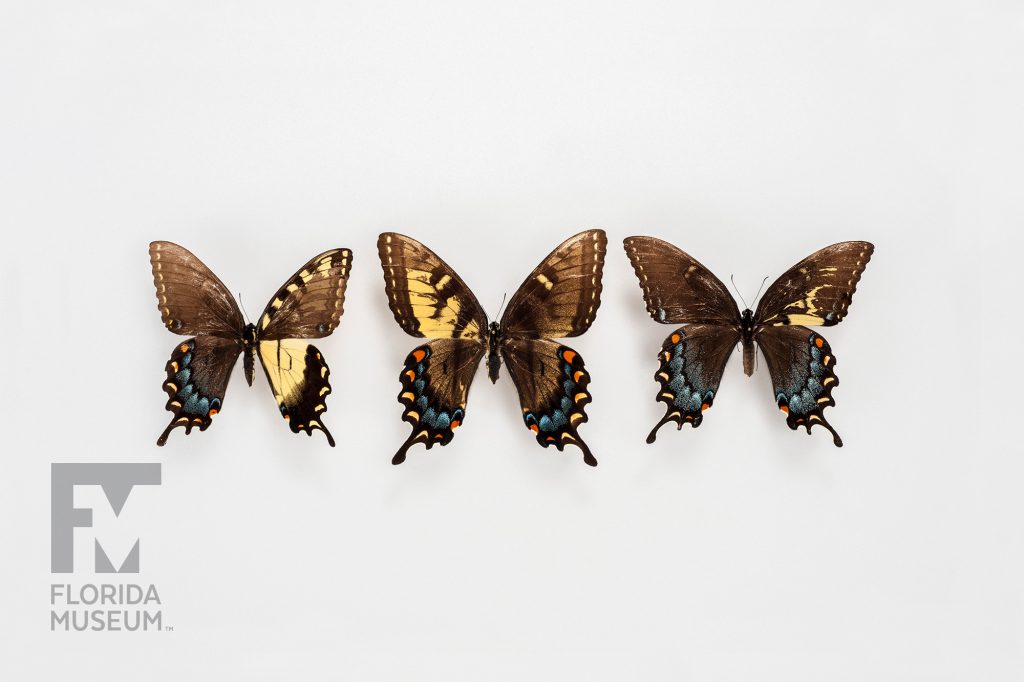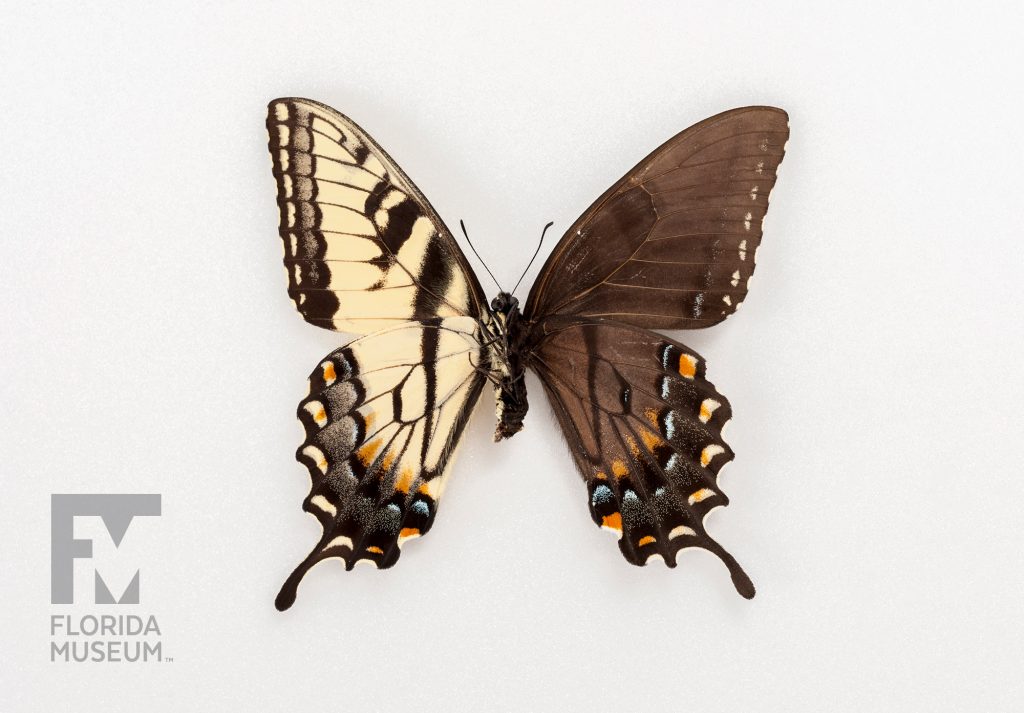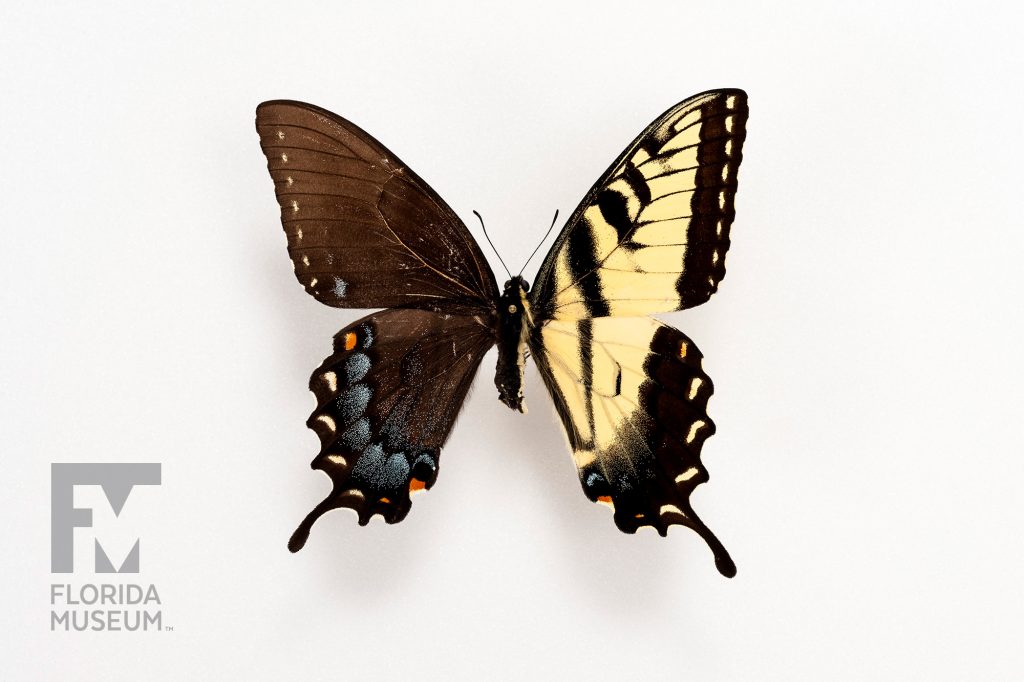Male and female butterflies often have different colors or patterns. Gynandromorphs—part male, part female—show a mix of both. Such anomalies, found once in 100,000 of wild butterflies, can result from mutations, disease, or errors during development.
Summary
Eastern Tiger Swallowtail (Papilio glaucus)
Male and Female from Florida, 1979
Gynandromorph reared in captivity at Michigan State University
Collection
Story
This specimen of a Tiger Swallowtail is a gynandromorph – an individual that is part male, part female. Gynandromorphy is interesting for a number of reasons. First of all, it is an aberration that concerns gender identity, something that people can relate to and find fascinating.
Gynandromorphs are quite rare in nature. There is only 1 in about 100,000. Personally, in all my 40 years of collecting and observing butterflies and moths, I have caught only one and have reared another one in the lab. Other lepidopterists will tell you a similar story. So, whenever somebody finds a gynandromorph specimen they make a big deal out of it.
This specimen was donated to our Museum by Mark Scriber who is a well-known scientist and research associate of the Museum. Mark raised this particular gynandromorph in the lab over the course of raising tens of thousands of normal Tiger Swallowtails, which we too have in our collection. He thought that the intermingling of two different species – the Canadian Tiger Swallowtail and the Eastern Tiger Swallowtail – might be behind the increase in the frequency of gynandromorphs found in the zone where the two species come together. Mark’s hypothesis is certainly supported by lab experiments in which people artificially crossed different species.
Finding aberrations like this is very important for the advancement of science, because they make scientists ask questions. The cause of perfect bilateral gynandromorphs — when an organism is split right down the middle, one-half male, another female — is thought to be the result of double fertilization of the binucleate egg. It means that an egg within a parent female accidently develops two nuclei, each with its own copy of maternal DNA. When this female mates, this egg is then fertilized by two spermatozoids – one carrying male genes, another, female. In humans such an embryo would not survive. In a butterfly, however, it develops into a half male-half female caterpillar, then pupa and then adult.
Most gynandromorphs among butterflies and moths are not male on one side, female on the other, but have features of the opposite sex seemingly randomly appearing throughout their body and wings. We call such specimens mosaic gynandromorphs. In reality they are mostly intersexes – genetically they are either males or females in all of their cells, but the opposite sex characteristics simply prevail. Expression of sex is regulated through biochemical pathways and these pathways can malfunction. When Richard Goldschmidt observed these intersexes in lab crosses of gypsy moths, he came up with a theory of how sex is regulated. At the time, he was working in Germany, but being Jewish, he had to flee the Nazis and settled in Berkeley, where he further developed his theories that led to the development of modern physiological genetics.
In addition to hybridization between different species, gynandromorphs can result from mutations. After the Chernobyl nuclear disaster, my colleagues and I described a population of butterflies in southern Russia with a high frequency of gynandromorphs. The Fukushima disaster in Japan prompted a detailed study of mutations in local populations of the Pale Grass Blue Butterfly, and it was found that caterpillars feeding on radioactive plants can result in increased mutations, including gynandromorphs.
As one can see, this specimen is not just a freak, but an important window into the way nature functions.
Andrei Sourakov
Collection Coordinator, McGuire Center for Lepidoptera and Biodiversity*
Florida Museum of Natural History
Exhibit
On display Sept. 23, 2017-Jan. 7, 2018, Rare, Beautiful & Fascinating: 100 Years @FloridaMuseum celebrated the Museum’s rich history. Each Museum collection was asked to contribute its most interesting items and share the stories that make them special. Though the physical exhibit is closed, this companion website remains online, providing an opportunity to experience the Florida Museum’s most treasured specimens.
Exhibit Area: Objects Tell Stories
Theme: Evolution
 Want to see more? Explore more than 300 breathtaking color photos of plants, animals, fossils and cultural heritage materials from the Florida Museum of Natural History’s collections in the award-winning book All Things Beautiful available from the University Press of Florida.
Want to see more? Explore more than 300 breathtaking color photos of plants, animals, fossils and cultural heritage materials from the Florida Museum of Natural History’s collections in the award-winning book All Things Beautiful available from the University Press of Florida.
*This title was accurate at the time the exhibit was on display in 2017. Please visit the collection website to verify current staff and student information.


